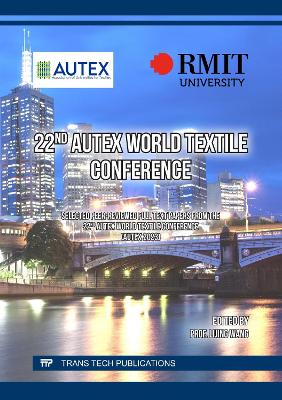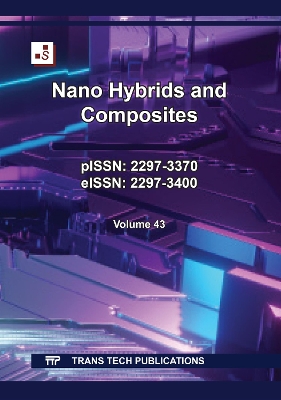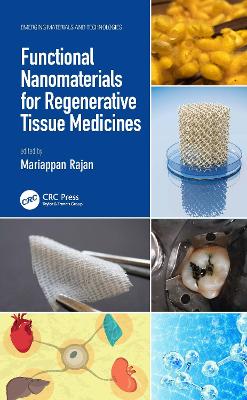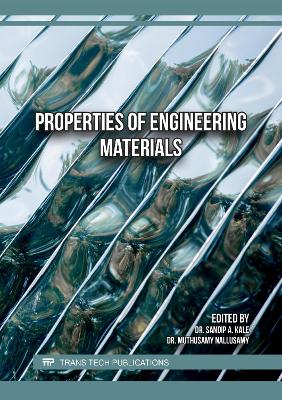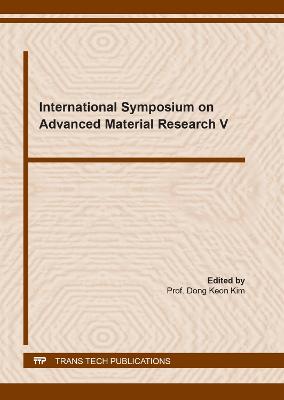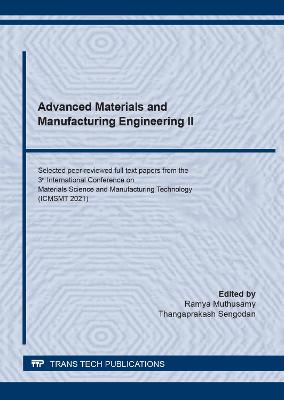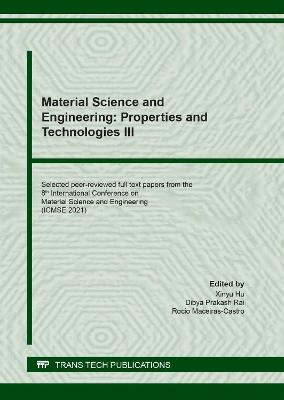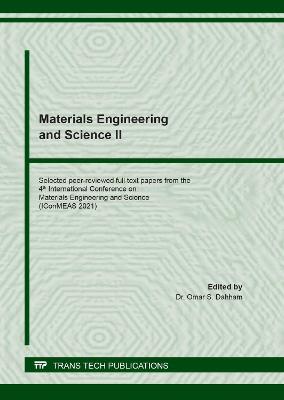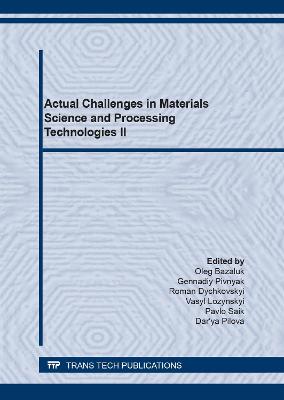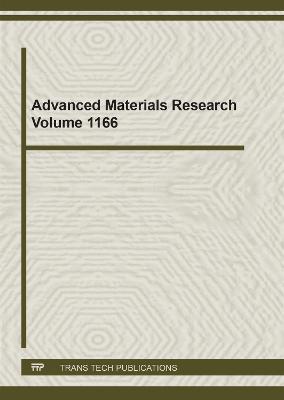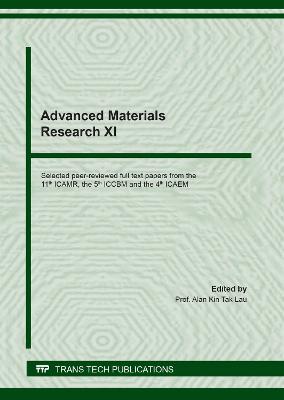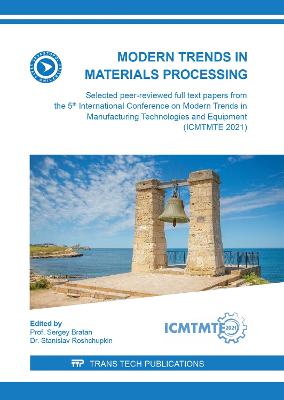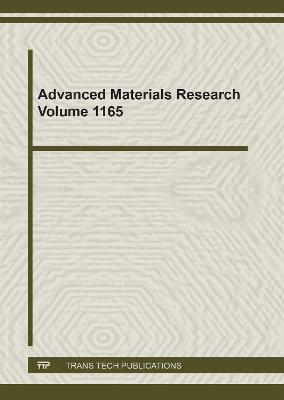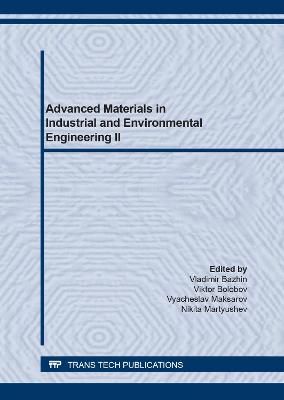FarEastCon - Materials and Construction III
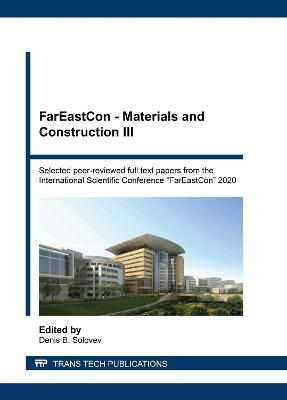 portes grátis
portes grátis
FarEastCon - Materials and Construction III
Solovev, Denis B.
Trans Tech Publications Ltd
06/2021
748
Mole
Inglês
9783035717761
15 a 20 dias
1380
Chapter 1: Special and Functional Materials
Thermotropic Copolyesters Based on Polyethylene Terephthalate and 4-Hydroxybenzoic Acid for High Modulus Fibers
Influence of Microwave on the Structure and Properties of Nanomodified Fluoroplastic
Synthesis of 5-Hydroxymethylfurfural-Acetone Resins
Surface Carboxylation of a Boron-Carbon BC5 Nanotube in the Development of Sensor Devices
Special Features of Formation of the High Damping State in Bimetallic Structural Materials Obtained by Explosion Welding
Features of Glass Plate Hardening by the Ion Exchange Method
Development of Titanium Implants with a Rough Calcium Phosphate Surface to Control the Morphofunctional State of Stem Cells
Investigation of the Thermal State of Parts to Justify the Possibility of Additive Forming of Nitinol Blanks In Situ
Electrochemical Sensors Based on Noble Metal Nanoparticles in Voltammetry
Investigation of BaSO4-KPO3-Na2B4O7 Low-Melting Glass System as a Basis for Synthesis of a Glass-Solder Material
Visualization of the Effect of an Impurity on the Optical Homogeneity of Lithium Niobate Doped with Boron Cations
Chapter 2: Polymers and Composites
Obtaining of Composite Alloys Based on Nickel Aluminides with Rare Metals
Research Investigation of Deformation Characteristics of Thin Polymer Films at Different Doses of Electron Irradiation
The Mechanism of Getting New Composite Polymer Materials with Improved Hardness Properties
Thermal Decomposition Characteristics of Poly((4-Vinylbenzyl) Trimethylammonium Bis (Trifluoromethanesulfonimide)) Studied by Pyrolysis-GS / MS
Towards a Strategy for the Synthesis of Polymeric Ionic Liquids with a Bulk Anion in Various Reaction Media
Development of Forming Method of Deployable Boom from Thermoplastic Polymer Composite
Effect of Wood Filler Concentration on Physical and Mechanical Properties of PLA-Based Composites
Investigation of the Staging of Damage Accumulation in Polymer Composite Materials during Bending and Tensile Tests
Oxidative Degradation of Polyethylene Filled with Nanosized Crushed Shells of Sea Oysters
Evaluation of the Influence of the Conditions of Catalytic Continuous Steam Explosive Activation of Wood on the Physical and Operational Properties of Wooded Composite Materials Based on Activated Fibers
Nanomodified Epoxy Materials with Improved Operating Characteristics
Physicochemical WPC Modification Techniques
Testing of Carbon Nanotubes and their Influence on the Physical and Mechanical Characteristics of Polyester Resin
Chapter 3: Materials and Technologies of Chemical Production
Fundamentally New Composite Materials of Fast Reactors Made on the Basis of Nanotechnology
Redox Behavior of Chelate Complexes Based on 8-Oxyquinoline Promising in OLED Display Technology
Purification of Zinc Oxide from Chlorides Using Microwave Radiation
Direct Synthesis of Titanium Nanoparticles by Induction Flow Levitation Technique
Polychelates Based on Magnesium, Aluminum, Iron, Zirconium, and Vanadyl Acetylacetonates - Synthesis, Structure and Properties
Optimization of the Choice of Technological Methods for Nanomodification of Natural Aluminosilicates through the Parameters of the Element-Oxygen Chemical Bond
Chapter 4: Properties and Processing Technologies of Steel and Alloys
Structure and Properties of Additive Hard Magnetic Alloys 25Cr15Co and Alnico
Microstructure-Impact Toughness Relationships in Quenched and Tempered Low Carbon Low Alloy Steels
Modern Technologies of Metal Processing in the Socio-Cultural Context
Mechanical and Corrosion Properties of VT6 Titanium Alloy after Irradiation with Helium and Aluminum Lons
Investigation of the Effect of Implantation of Aluminum Alloys by Gas and Metal Ions on the Structure and Phase Composition of the Implanted Layer
Research of Properties of Austenitic Steels
Elasticity Modulus and Hardness of Bearing Steel after Laser Treatment
Amorphous Alloys Atomic Structure Investigation by Means of Electron Microscopy and Diffraction
Development of Combined Rolling-Extruding Modes for Producing Longish Deformed Semi-Finished Products from Aluminum Alloy with Low Cerium Content
Influence of Structure and Dispersivity of Copper on its Melting Features
Features of Structural-Phase Transformations during Oxidation of Metals with Bulk Submicrocrystalline Structure and Fine Metal Powders
Channel Angular Pressing of the Annular Metal Billet
Grinding of Titanium Alloys
Features of the Structure of the Material Formed from AK4-1 Powder Using Laser Energy
Experimental and Analytical Assessment of the Power Parameters of the Combined Rolling-Extruding Process Using a Round Billet from Alloy 01417 Obtained Using an Electromagnetic Mold
Chapter 5: Tribology, Coatings and Surface Engineering
Features of the Formation of Structure and Geometry during Direct Laser Deposition of 321L Stainless Steel on Complex Groove Using the LENS Method
Study of the Impact of Protective Process Agents with Carbon Nanopowder Additives on Chip Forming Processes
Kinetic Characteristics of Electrodeposition of Ni-Co-Al2O3 Composite Coating
Chemical Processes in PEO Coatings Formation and Destruction on Titanium Alloy VT-1
Improving the Tribological Properties of Ceramic Dies
Heat Treatment of the Surface of the ChS57 Alloy with Powerful Nanosecond Ultraviolet Laser Pulses
Metallographic and Eddy Current Study of Boride Strengthening Coatings
The Effect of Surface Conditions on Corrosion Resistance of a Cobalt-Chromium Alloy
On the Issue of Laser Selective Removal of Paint Coating from a Sample of Metal Plating of Aircraft Gliders
Structural-Mechanical Properties of Polyurethane Surface after Carbon Ion Subplantation
The Effect Covering on the Change in the Properties of Hard Alloys
Impact of Nanodispersed Diamond Graphite Additive on Metal Cutting Temperature
Precast Textured Tool and the Construction of an Intensive Grinding Process Based on It
Chapter 6: Materials and Technologies in Construction
Studies of the Influence of Graphite on the Physical Mechanical and Thermal Properties of Polyurethane Foams for Construction Applications
On the Durability of Concrete under the Action of Ultra-Low (up to -196 degreesC) Technological Temperatures
Cement Building Materials with Powdered Optical Discs as a Filler
Effective Fine Concrete Modified with a Highly Dispersed Wollastonite-Based Additive
Modified Gypsum Binder for Plastering Systems
Thermal Changes in the Mass, Size and Density of Steel Fiber Concrete after Calefaction
Use of Bacterial Carbonatogenesis to Increase the Strength of Cement Solutions with the Help of Microorganisms
Building Systems Based on Foamed Modified Polymers
The Influence of Ferrous Metallurgy Waste in the Aktobe Region on the Frost Resistance of Ceramic Bricks Based on Low-Melting Clay
Assessment of the Impact of High Temperature on the Strength of Reinforced Concrete Structures during Operation
Investigation of the Rate of Vacuum-Conductive Drying of Wood-Particle Panels Based on Polyvinyl Alcohol
Effect of Cement Paste Preparation Procedure and Cement Stone Age on its Phase Composition
Unused Plant Waste and Thermal Insulation Composition Boards on their Basis
Sulfide Technology Based on Sulfur Waste Product of Coke Production
Filled Heat Efficient Ceramics
Theoretical Assessment of the Prospects for the Use of Raw Materials in Ceramic Production
Polymer-Bitumen Binders Compositions Selection by Using the Experimental Planning Method
The Use of Waste from the Processing of Copper-Zinc Concentrates of the East Kazakhstan Region in the Production of Non-Fired Refractory Composites
Analysis of the Quality of Quartz-Feldspar Sand as a Component of a Composite Binder
Influence of Fillers on Silicate Compositions Porization
Research of Physical and Mechanical Properties of Fly Ash Ceramics with SiO2 and Al2O3 Nanoparticles as Functional Addition
Extreme Modelling of Concrete Optimal Composition and Content of the Components
Determination of the Chemical Composition of Corrosion Defects on the Inner Surfaces of Hollow Reinforced Concrete Structures
Chapter 7: Computational Procedures, Modelling and Numerical Simulation in Materials Science
System Analysis and Control of the Influence of a Mixed Type of Chemical Bond in Substances and Materials on their Structure and Properties
Modeling of the Process of Drying and Coalescing Nanodispersion Spreading
Finite-Element Simulation of Steckel Mill Rolling
Methodology for Calculating Heat Loss in the Study of Friction Stir Welding
Investigation of Surface-Functionalized CNT-Based Array for Detection of Acetone Vapors
Evaluation of Pozzolanic Activity of Metakaolin Chemometric Method According to the UV-VIS-NIR Spectroscopy
Effect of Initial Conditions and Numerical Investigation of Instability Developed during Synthesis of TiC via Vortex Combustion at Moderate Temperatures. Model of Vortex Combustion
Statistical Model of a Thin Film Formation
Finding the Specific Surface Area of an Organomineral Sorbent Produced by Electroplasma Treatment of Coal Flotation Waste
Generalized Susceptibility of Mixed Dislocation in Ferroelastics near Structural Phase Transition
Chapter 8: Deformation and Fracture Mechanics of Materials in Mechanical Engineering
The Influence of Technological and Operational Factors on the Durability of the Shafts of Air-Cooler Unit Electric Motors
Calculated Model of Endurance Limit Estimation Based on Structural-Strain Analysis of the Critical Condition of Ferrite-Perlite Steels with Macrocracks in Ship Structures
Shock Loading of Heteromodular Elastic Materials under Plane-Strain Condition
The Problem of Stretching a Hollow Cylinder
Investigation of Low-Cycle Fatigue on Structural Carbon Steel
Relieving of Residual Stresses in Metal Workpieces at High and Low Temperatures
Designing of Thin Composite Panels with the Post-Buckling Behavior Considering Rigid Support and Loading with Shear Flows
Chapter 9: Deformation and Fracture of Materials and Structure Elements in Construction
The Construction of the Diagrammatic Deformation Model for Calculating the Core Reinforced-Concrete Structures in Finite Increments under Joint Action of Load Increments and Variable by Cross Sections Low and Ultra Low Subzero Temperatures
Seismic Resistance of Nonlinearly Deformable Large-Span Spatial Structures, Taking into Account Changing Dynamic Stiffness
Deformation of Steel-Reinforced Concrete Round Thin Slabs Taking into Account the Compliance of the Support Contour
Behavior of Polygonal Shells of Complex Geometry, Taking into Account the History of a High Level of Loading
Dynamic Parameters of Prestressed Hanging Systems
On the Influence of Interlayer Nonuniformity on Contact Characteristics during the Interaction of a Pipe and a Rigid Cylindrical Insert
Strain-Stress Distribution of Structural Components from Foam Concrete for Monolithic Construction
Study of Nonlinear Stress-Strain Diagram of Concrete Based on Local Raw Materials in Central Yakutia
Chapter 1: Special and Functional Materials
Thermotropic Copolyesters Based on Polyethylene Terephthalate and 4-Hydroxybenzoic Acid for High Modulus Fibers
Influence of Microwave on the Structure and Properties of Nanomodified Fluoroplastic
Synthesis of 5-Hydroxymethylfurfural-Acetone Resins
Surface Carboxylation of a Boron-Carbon BC5 Nanotube in the Development of Sensor Devices
Special Features of Formation of the High Damping State in Bimetallic Structural Materials Obtained by Explosion Welding
Features of Glass Plate Hardening by the Ion Exchange Method
Development of Titanium Implants with a Rough Calcium Phosphate Surface to Control the Morphofunctional State of Stem Cells
Investigation of the Thermal State of Parts to Justify the Possibility of Additive Forming of Nitinol Blanks In Situ
Electrochemical Sensors Based on Noble Metal Nanoparticles in Voltammetry
Investigation of BaSO4-KPO3-Na2B4O7 Low-Melting Glass System as a Basis for Synthesis of a Glass-Solder Material
Visualization of the Effect of an Impurity on the Optical Homogeneity of Lithium Niobate Doped with Boron Cations
Chapter 2: Polymers and Composites
Obtaining of Composite Alloys Based on Nickel Aluminides with Rare Metals
Research Investigation of Deformation Characteristics of Thin Polymer Films at Different Doses of Electron Irradiation
The Mechanism of Getting New Composite Polymer Materials with Improved Hardness Properties
Thermal Decomposition Characteristics of Poly((4-Vinylbenzyl) Trimethylammonium Bis (Trifluoromethanesulfonimide)) Studied by Pyrolysis-GS / MS
Towards a Strategy for the Synthesis of Polymeric Ionic Liquids with a Bulk Anion in Various Reaction Media
Development of Forming Method of Deployable Boom from Thermoplastic Polymer Composite
Effect of Wood Filler Concentration on Physical and Mechanical Properties of PLA-Based Composites
Investigation of the Staging of Damage Accumulation in Polymer Composite Materials during Bending and Tensile Tests
Oxidative Degradation of Polyethylene Filled with Nanosized Crushed Shells of Sea Oysters
Evaluation of the Influence of the Conditions of Catalytic Continuous Steam Explosive Activation of Wood on the Physical and Operational Properties of Wooded Composite Materials Based on Activated Fibers
Nanomodified Epoxy Materials with Improved Operating Characteristics
Physicochemical WPC Modification Techniques
Testing of Carbon Nanotubes and their Influence on the Physical and Mechanical Characteristics of Polyester Resin
Chapter 3: Materials and Technologies of Chemical Production
Fundamentally New Composite Materials of Fast Reactors Made on the Basis of Nanotechnology
Redox Behavior of Chelate Complexes Based on 8-Oxyquinoline Promising in OLED Display Technology
Purification of Zinc Oxide from Chlorides Using Microwave Radiation
Direct Synthesis of Titanium Nanoparticles by Induction Flow Levitation Technique
Polychelates Based on Magnesium, Aluminum, Iron, Zirconium, and Vanadyl Acetylacetonates - Synthesis, Structure and Properties
Optimization of the Choice of Technological Methods for Nanomodification of Natural Aluminosilicates through the Parameters of the Element-Oxygen Chemical Bond
Chapter 4: Properties and Processing Technologies of Steel and Alloys
Structure and Properties of Additive Hard Magnetic Alloys 25Cr15Co and Alnico
Microstructure-Impact Toughness Relationships in Quenched and Tempered Low Carbon Low Alloy Steels
Modern Technologies of Metal Processing in the Socio-Cultural Context
Mechanical and Corrosion Properties of VT6 Titanium Alloy after Irradiation with Helium and Aluminum Lons
Investigation of the Effect of Implantation of Aluminum Alloys by Gas and Metal Ions on the Structure and Phase Composition of the Implanted Layer
Research of Properties of Austenitic Steels
Elasticity Modulus and Hardness of Bearing Steel after Laser Treatment
Amorphous Alloys Atomic Structure Investigation by Means of Electron Microscopy and Diffraction
Development of Combined Rolling-Extruding Modes for Producing Longish Deformed Semi-Finished Products from Aluminum Alloy with Low Cerium Content
Influence of Structure and Dispersivity of Copper on its Melting Features
Features of Structural-Phase Transformations during Oxidation of Metals with Bulk Submicrocrystalline Structure and Fine Metal Powders
Channel Angular Pressing of the Annular Metal Billet
Grinding of Titanium Alloys
Features of the Structure of the Material Formed from AK4-1 Powder Using Laser Energy
Experimental and Analytical Assessment of the Power Parameters of the Combined Rolling-Extruding Process Using a Round Billet from Alloy 01417 Obtained Using an Electromagnetic Mold
Chapter 5: Tribology, Coatings and Surface Engineering
Features of the Formation of Structure and Geometry during Direct Laser Deposition of 321L Stainless Steel on Complex Groove Using the LENS Method
Study of the Impact of Protective Process Agents with Carbon Nanopowder Additives on Chip Forming Processes
Kinetic Characteristics of Electrodeposition of Ni-Co-Al2O3 Composite Coating
Chemical Processes in PEO Coatings Formation and Destruction on Titanium Alloy VT-1
Improving the Tribological Properties of Ceramic Dies
Heat Treatment of the Surface of the ChS57 Alloy with Powerful Nanosecond Ultraviolet Laser Pulses
Metallographic and Eddy Current Study of Boride Strengthening Coatings
The Effect of Surface Conditions on Corrosion Resistance of a Cobalt-Chromium Alloy
On the Issue of Laser Selective Removal of Paint Coating from a Sample of Metal Plating of Aircraft Gliders
Structural-Mechanical Properties of Polyurethane Surface after Carbon Ion Subplantation
The Effect Covering on the Change in the Properties of Hard Alloys
Impact of Nanodispersed Diamond Graphite Additive on Metal Cutting Temperature
Precast Textured Tool and the Construction of an Intensive Grinding Process Based on It
Chapter 6: Materials and Technologies in Construction
Studies of the Influence of Graphite on the Physical Mechanical and Thermal Properties of Polyurethane Foams for Construction Applications
On the Durability of Concrete under the Action of Ultra-Low (up to -196 degreesC) Technological Temperatures
Cement Building Materials with Powdered Optical Discs as a Filler
Effective Fine Concrete Modified with a Highly Dispersed Wollastonite-Based Additive
Modified Gypsum Binder for Plastering Systems
Thermal Changes in the Mass, Size and Density of Steel Fiber Concrete after Calefaction
Use of Bacterial Carbonatogenesis to Increase the Strength of Cement Solutions with the Help of Microorganisms
Building Systems Based on Foamed Modified Polymers
The Influence of Ferrous Metallurgy Waste in the Aktobe Region on the Frost Resistance of Ceramic Bricks Based on Low-Melting Clay
Assessment of the Impact of High Temperature on the Strength of Reinforced Concrete Structures during Operation
Investigation of the Rate of Vacuum-Conductive Drying of Wood-Particle Panels Based on Polyvinyl Alcohol
Effect of Cement Paste Preparation Procedure and Cement Stone Age on its Phase Composition
Unused Plant Waste and Thermal Insulation Composition Boards on their Basis
Sulfide Technology Based on Sulfur Waste Product of Coke Production
Filled Heat Efficient Ceramics
Theoretical Assessment of the Prospects for the Use of Raw Materials in Ceramic Production
Polymer-Bitumen Binders Compositions Selection by Using the Experimental Planning Method
The Use of Waste from the Processing of Copper-Zinc Concentrates of the East Kazakhstan Region in the Production of Non-Fired Refractory Composites
Analysis of the Quality of Quartz-Feldspar Sand as a Component of a Composite Binder
Influence of Fillers on Silicate Compositions Porization
Research of Physical and Mechanical Properties of Fly Ash Ceramics with SiO2 and Al2O3 Nanoparticles as Functional Addition
Extreme Modelling of Concrete Optimal Composition and Content of the Components
Determination of the Chemical Composition of Corrosion Defects on the Inner Surfaces of Hollow Reinforced Concrete Structures
Chapter 7: Computational Procedures, Modelling and Numerical Simulation in Materials Science
System Analysis and Control of the Influence of a Mixed Type of Chemical Bond in Substances and Materials on their Structure and Properties
Modeling of the Process of Drying and Coalescing Nanodispersion Spreading
Finite-Element Simulation of Steckel Mill Rolling
Methodology for Calculating Heat Loss in the Study of Friction Stir Welding
Investigation of Surface-Functionalized CNT-Based Array for Detection of Acetone Vapors
Evaluation of Pozzolanic Activity of Metakaolin Chemometric Method According to the UV-VIS-NIR Spectroscopy
Effect of Initial Conditions and Numerical Investigation of Instability Developed during Synthesis of TiC via Vortex Combustion at Moderate Temperatures. Model of Vortex Combustion
Statistical Model of a Thin Film Formation
Finding the Specific Surface Area of an Organomineral Sorbent Produced by Electroplasma Treatment of Coal Flotation Waste
Generalized Susceptibility of Mixed Dislocation in Ferroelastics near Structural Phase Transition
Chapter 8: Deformation and Fracture Mechanics of Materials in Mechanical Engineering
The Influence of Technological and Operational Factors on the Durability of the Shafts of Air-Cooler Unit Electric Motors
Calculated Model of Endurance Limit Estimation Based on Structural-Strain Analysis of the Critical Condition of Ferrite-Perlite Steels with Macrocracks in Ship Structures
Shock Loading of Heteromodular Elastic Materials under Plane-Strain Condition
The Problem of Stretching a Hollow Cylinder
Investigation of Low-Cycle Fatigue on Structural Carbon Steel
Relieving of Residual Stresses in Metal Workpieces at High and Low Temperatures
Designing of Thin Composite Panels with the Post-Buckling Behavior Considering Rigid Support and Loading with Shear Flows
Chapter 9: Deformation and Fracture of Materials and Structure Elements in Construction
The Construction of the Diagrammatic Deformation Model for Calculating the Core Reinforced-Concrete Structures in Finite Increments under Joint Action of Load Increments and Variable by Cross Sections Low and Ultra Low Subzero Temperatures
Seismic Resistance of Nonlinearly Deformable Large-Span Spatial Structures, Taking into Account Changing Dynamic Stiffness
Deformation of Steel-Reinforced Concrete Round Thin Slabs Taking into Account the Compliance of the Support Contour
Behavior of Polygonal Shells of Complex Geometry, Taking into Account the History of a High Level of Loading
Dynamic Parameters of Prestressed Hanging Systems
On the Influence of Interlayer Nonuniformity on Contact Characteristics during the Interaction of a Pipe and a Rigid Cylindrical Insert
Strain-Stress Distribution of Structural Components from Foam Concrete for Monolithic Construction
Study of Nonlinear Stress-Strain Diagram of Concrete Based on Local Raw Materials in Central Yakutia

